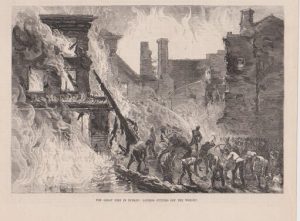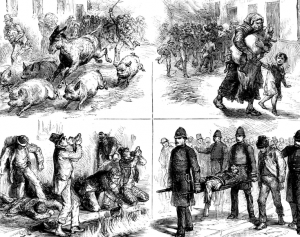The Great Liberties Whiskey Fire

The crowed that had gathered to watch the ‘entertainment’ wasted no time in collecting the mixture of unseasoned faecally-contaminated alcohol immersed in tannery sludge, lashing into the whiskey with hastily gathered pots, pans, boots and even hats.
The streets ran with burning whiskey and pandemonium ensued. An online event exploring ‘The Great Liberties Whiskey Fire’ took place recently as part of the Dublin Festival of History 2020 line-up.
In ‘The Great Liberties Whiskey Fire’ Las Fallon, a retired Dublin firefighter, historian and author, told the story of a forgotten piece of Dublin history and of the fire, the destruction and mayhem it caused as well as the unusual method used to put it out.
The warehouse was indeed massive – the biggest in Dublin – and was the seat of the biggest fire in Dublin of the 19th Century.
It was owned by Lawrence Malone who bought a premises in the Coombe’s Ardee Street in Dublin’s Liberties area.
It housed 1,800 ‘puncheons’ – larger than a hogshead – of whiskey, all of which equated 570,000 litres of spirits, up to 5,000 barrels in total in the premises, comprising port, brandy and other spirits.
Behind the locked doors rested various whiskey brands such as Powers, John Jameson and James Jameson as well as whiskeys from smaller distilleries such as DWD and Greenmount. Brandies too were stored there.
In all some €6 million-worth of spirits would be lost that night alongside the 40 houses that also burned down while others were severely damaged by the fires.
The first anyone knew of the conflagration was when blue flames – imagine the flame from the brandy on a Christmas pudding – burst through the roof of the building.
Dublin’s three year-old Fire Brigade, led by a Captain James Robert Ingram, was soon on the scene.
By this time the huge fire of burning flowing whiskey was pouring out of the doors & windows of the warehouse, making its incendiary way from Ardee Street down the hill towards Mill Street.
The burning liquid flowed into every corner and laneway.
The quandary for Captain Ingram was how could the liquid blaze be tackled? He realised straight away that he had to block up the drains and sewers to prevent the tributary of fire reaching the adjacent River Poddle – and to prevent the city exploding as the flames met with the methane gas in the city’s sewers.
He tried digging up the streets in front of the fire but that didn’t work.
What he needed was an absorbent material to soak up the burning whiskey and dam the ‘fuel’ until it burned out.
Then he’d a foul brainwave.
With horses providing all of the city’s transportation needs, there would be no shortage of dung collected and kept at the Corporation depot nearby. Captain Ingram ordered it to be delivered to the scene of the fire fast.
The warehouse was also surrounded by tanneries who soaked their animal hides in a pungent mixture of dog faeces, urine and animal brains (don’t try this at home).
The resulting waste sludge was also called for as was the human waste from the nearby abodes that ran into ‘ash pits’ regularly collected by the Corporation.
That seemed to do the trick and the burning spirits soaked into this organic dam, thus stopping the flow.
What the smell around the place must have been like on the night one can only imagine but despite the fact that nobody died from the fire itself, there were fatalities.
The crowed that had gathered to watch the ‘entertainment’ wasted no time in collecting the mixture of unseasoned faecally-contaminated alcohol immersed in tannery sludge, lashing into the whiskey with hastily gathered pots, pans, boots and even hats.
Those without these got down on their hands and knees to lap it up.
In all, 14 died of alcohol poisoning or simply poisoning considering the matrix on offer that night.
Las has written three books on the history of the Dublin Fire Brigade and taken part in documentaries with RTE, TG4, BBC and others on the 1916 Rising, the Civil War, the Belfast Blitz and other subjects.
Apart from Las’s book, The Great Liberties Whiskey Fire:Dublin`s forgotten calamity of 1875 (available in Teelings Distillery nearby and the Irish Whiskey Museum or from www.kilmainhamtales.ie) a podcast is also available as part of the Three Castles Burning podcast series.

The crowed that had gathered to watch the ‘entertainment’ wasted no time in collecting the mixture of unseasoned faecally-contaminated alcohol immersed in tannery sludge, lashing into the whiskey with hastily gathered pots, pans, boots and even hats.






